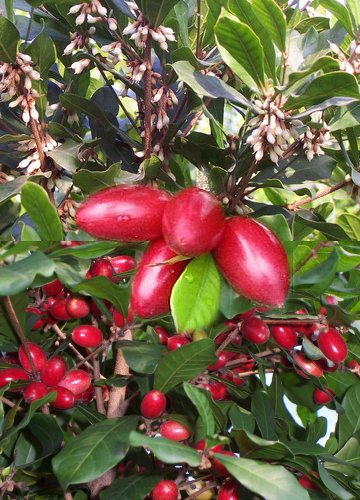
|
|
Miracle fruit
(Synsepalum dulcificum)
|
Miracle fruit - Synsepalum dulcificum
Synsepalum dulcificum produces berries that, when eaten, cause sour foods (such as lemons and
limes) subsequently consumed to taste sweet. This effect is due to miraculin, which is used commercially as a sugar
substitute. Common names for this species and its berry include miracle fruit and miracle
berry. These common names are shared also by Gymnema sylvestre and Thaumatococcus
daniellii, two other species that are used to alter the perceived sweetness of
foods. Additional common names include miraculous berry and sweet berry. In West Africa where the species
originates, common names include agbayun, taami, asaa, and ledidi.
The plant is a shrub that grows up to 20 feet (6.1 m) high in its native habitat, but does not usually grow higher than ten feet in
cultivation. Its leaves are 5-10 cm long, 2-3.7 cm wide and glabrous below. They are clustered at the ends of the
branchlets. The flowers are brown. It carries red, 2 cm long fruits. Each fruit contains one
seed.
It is one of the strangest tropical fruits. The most unusual thing about it is the effect it has on one's taste after this miraculous berry has been
consumed. The "miracle" is that if lemon or other sour food is eaten after the miracle
fruit, the sour tastes sweet, as if sugar has been added. That kind of magical experience is
unforgettable! The interest in this plant is so high that anyone who has a plant always finds eager volunteers to test its sweetening
properties. A natural chemical in the fruit masks the tongue's sour taste buds so that lemons taste like lemonade or lemon
pie, or lemon candy. What causes the miracle? The berry itself has a low sugar
content and a mildly sweet tang. However the fruit has a unique taste changing glycoprotein with some trailing carbohydrate chains, called miraculin. This protein inhibits
tastebuds' perception of sour taste. When the fleshy part of the fruit is
eaten, this molecule binds to the tongue's taste buds, causing sour foods to taste
sweet. While the exact cause for this change is unknown, one theory is that miraculin works by distorting the shape of sweetness receptors
"so that they become responsive to acids, instead of sugar and other sweet
things". This effect lasts until the protein is washed away by saliva (up to about 60
minutes).
The berry has been used in West Africa since at least the 18th century, when European explorer Chevalier des
Marchais, who searched for many different fruits during a 1725 excursion to its native West
Africa, provided an account of its use there. Marchais noticed that local people picked the berry from shrubs and chewed it before
meals. In West Africa, the native diet revolved around a few basic
foods, mostly of sour taste. Just imagine the delight of the people when someone ate a few red berries and later ate a meal of sour
foods, to find everything suddenly sweet! The West African natives use the fruit to sweeten sour palm wine
(beer) - Pito, and fermented maize bread - Kenkey.
An attempt was made in the 1970s to commercialize the ability of the fruit to turn unsweet foods into sweet foods without a caloric penalty, but ended in failure when the U.S. Food and Drug Administration (FDA) classified the berry as a food additive. There were controversial circumstances with accusations that the project was sabotaged and the research burgled by the sugar industry to prevent loss of business caused by a drop in the need for sugar. The FDA has always denied that pressure was put on it by the sugar industry, but refused to release any files on the subject. Similar arguments are noted for the FDA's regulation on stevia now labeled as a "dietary supplement" instead of a
"sweetener".
For a time in the 1970s, US dieters could purchase a pill form of miraculin. The idea of the "miraculin party" was conceived then. Recently, this phenomenon has enjoyed some revival in food-tasting events, referred to as "flavor-tripping parties" by some. The tasters consume sour and bitter foods, such as lemons, radishes, pickles, hot sauce, and beer, to experience the taste changes that
occur.
Attempts have been made to create a commercial sweetener from the fruit, with an idea of developing this for
diabetics. Fruit cultivators also report a small demand from cancer patients, because the fruit allegedly counteracts a metallic taste in the mouth that may be one of the many side effects of
chemotherapy. This claim has not been researched scientifically, though in late 2008, an oncologist at Mount Sinai Medical Center in
Miami, Florida, began a study, and by March 2009, had filed an investigational new drug application with the
U.S. Food and Drug Administration. In Japan, miracle fruit is popular among diabetics and
dieters. Today, it is being cultivated in Ghana, Puerto Rico, Taiwan, and South
Florida.
Source:
http://en.wikipedia.org/wiki/Synsepalum_dulcificum
http://toptropicals.com/html/toptropicals/plant_wk/synsepalum.htm
